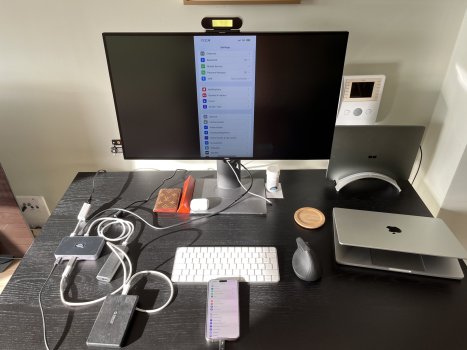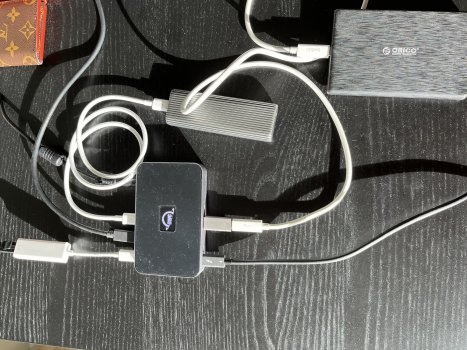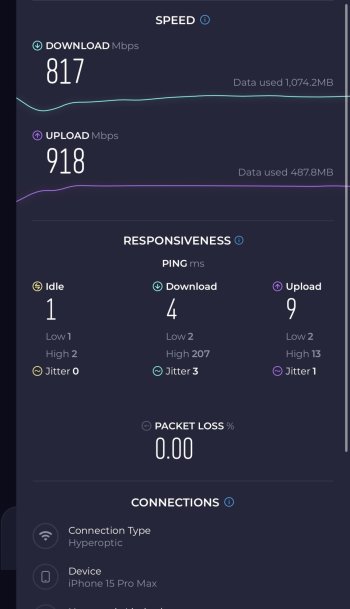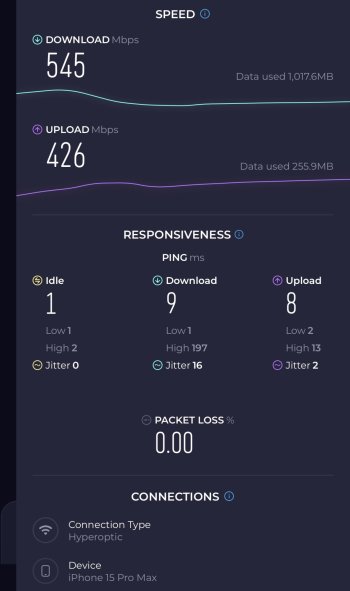TLDR: I plugged seven devices including a display and three drives to the iPhone. Woah.
Connection Tree
So today I decided to find the limits of the USB-C port on the iPhone 15 Pro Max and in the process made interesting discoveries.
Why I tried that
I was looking for a USB-C hub that has downstream USB-C ports that carry USB-C DisplayPort Alt Mode.
Let me explain: save for a few niche exceptions, you can’t plug a USB-C display to a USB-C hub because the hub won’t push down the DP signal.
Therefore this connection tree wouldn’t work:
Only the following would work:
However, it turns out that with Thunderbolt (4?) hubs (or at least the OWC one), it IS possible to connect a USB-C display to the hub! The hub passes down the DisplayPort signal.
But that’s not it: as the diagram shows, I was able to also connect accessories to the hub of the USB-C display.
There isn’t a tool on iOS to do USB-C speed tests, so what I did is record a AppleProRes video to my NVMe drive while keeping everything else plugged.
During the recording, I did an internet speed test and plugged another drive to see how it would affect the quality of the recording (if the bandwidth decreases, the recording will drop frames)
The only time it dropped frames was when I plugged another drive. The internet speed test was half what I usually get, pointing out to the bandwidth limits of USB 3.2 Gen 2.
Quite spectacular that the iPhone can handle recording ProRes through a Thunderbolt hub that has a display and several drives connected!
Connection Tree
iPhone 15 Pro Max
OWC Thunderbolt 4 Hub
Dell U2720Q USB-C DisplayYubikeyUSB-C DriveGigabit Ethernet AdapterUSB-C NVMe DriveUSB 3.2 SATA Drive
So today I decided to find the limits of the USB-C port on the iPhone 15 Pro Max and in the process made interesting discoveries.
Why I tried that
I was looking for a USB-C hub that has downstream USB-C ports that carry USB-C DisplayPort Alt Mode.
Let me explain: save for a few niche exceptions, you can’t plug a USB-C display to a USB-C hub because the hub won’t push down the DP signal.
Therefore this connection tree wouldn’t work:
iPhone
USB-C HubUSB-C Display
Only the following would work:
iPhone
USB-C DisplayUSB-C Hub
However, it turns out that with Thunderbolt (4?) hubs (or at least the OWC one), it IS possible to connect a USB-C display to the hub! The hub passes down the DisplayPort signal.
NB: if an engineer can explain my questions below, that would be helpful:
- why USB-C hubs can’t do that
- And why Thunderbolt hubs with a device that isn’t even Thunderbolt can do it
But that’s not it: as the diagram shows, I was able to also connect accessories to the hub of the USB-C display.
There isn’t a tool on iOS to do USB-C speed tests, so what I did is record a AppleProRes video to my NVMe drive while keeping everything else plugged.
During the recording, I did an internet speed test and plugged another drive to see how it would affect the quality of the recording (if the bandwidth decreases, the recording will drop frames)
The only time it dropped frames was when I plugged another drive. The internet speed test was half what I usually get, pointing out to the bandwidth limits of USB 3.2 Gen 2.
Quite spectacular that the iPhone can handle recording ProRes through a Thunderbolt hub that has a display and several drives connected!
Attachments
Last edited:






